Marcelo Bielsa’s Leeds United were unarguably the best team in the EFL Championship this season. Earlier this week, we have published the analysis on explaining their rotations and pressing system respectively. In our June magazine, we analyse their build-up plays and in this tactical analysis, we will provide you with a scout report on their performances during the transition phases.
The dominance of Leeds was reflected in terms of numbers. Currently, they are the top of the league, while having scored the most goals and conceded the fewest.
Leeds had the highest average possession per game (62.7%) and the lowest PPDA (6.31) in the league. Apart from the consistent build-up plays and the pressing, their strong performance during the transitions was also a factor. We knew the intensive football coached by Bielsa, and the same standard is also applied whenever they lost the ball. At the other end, they also tried to create counter-attacking opportunities as long as they were regaining possession.
Counter-pressing
Just like all other counter-press methods, the defending team tried to win the ball as soon as possible by achieving some objectives. For Bielsa’s team, the objectives were to force a backward pass or a long ball, if the initial defensive action did not help to recover the ball.
The counter-press of Leeds combined elements of man-marking, ball approaching, and shutting the passing lanes. In general, during a possession turnover, the player nearest to the ball approached the ball. Meanwhile, players around him should cover passing options around the ball. This gave a hard task for the opponent, as he was confronting pressure but his short options were risky to receive. This helped Leeds to recover possession high if the opponent tried to escape with a short pass. If the ball went long, the centre-backs were strong to win the duels.
An important element of Leeds’ counter-press was the diagonal runs from flanks. We prepared an example to explain the details of this approach. But the question is: how to create conditions for players to begin the press at flanks? A huge part of this was attributed to the offensive tactics of the team. As we explained in our previous analysis, Leeds attacked flanks with rotations instead of sticking centrally. Therefore, they were quite likely to lose the ball wide, hence what triggered these runs.
The below graph summarised the percentages of ball possession losses by Leeds in recent fixtures. A total of 61.3% of their ball loss occurred at flanks (zone 7, 10, 13 and 16; zone 9, 12, 15 and 18). At the meantime, only 5.4% ball losing events occurred around the central circle.
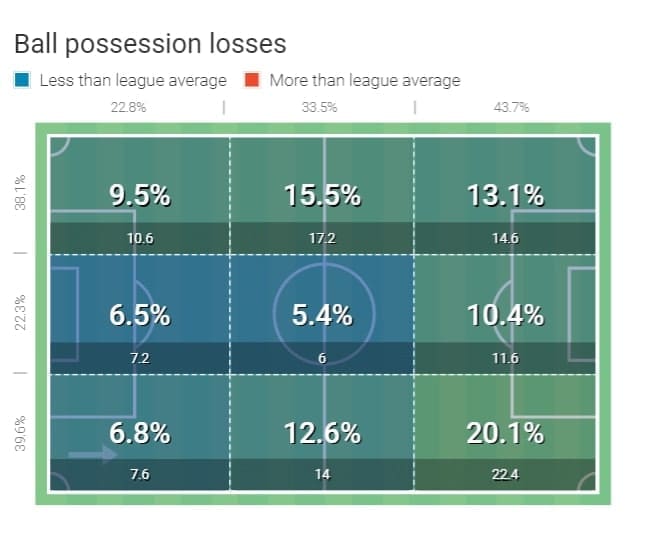
Let us dive into a game example to have a clearer view of their counter-press. In this scenario, Leeds were trying to counter-press Derby County as they lost the second ball. During the return pass, the nearest player immediately pushed forward to pressure the keeper. At the meantime, both short options were controlled by another two Leeds players, so this forced Kelle Roos to go long.
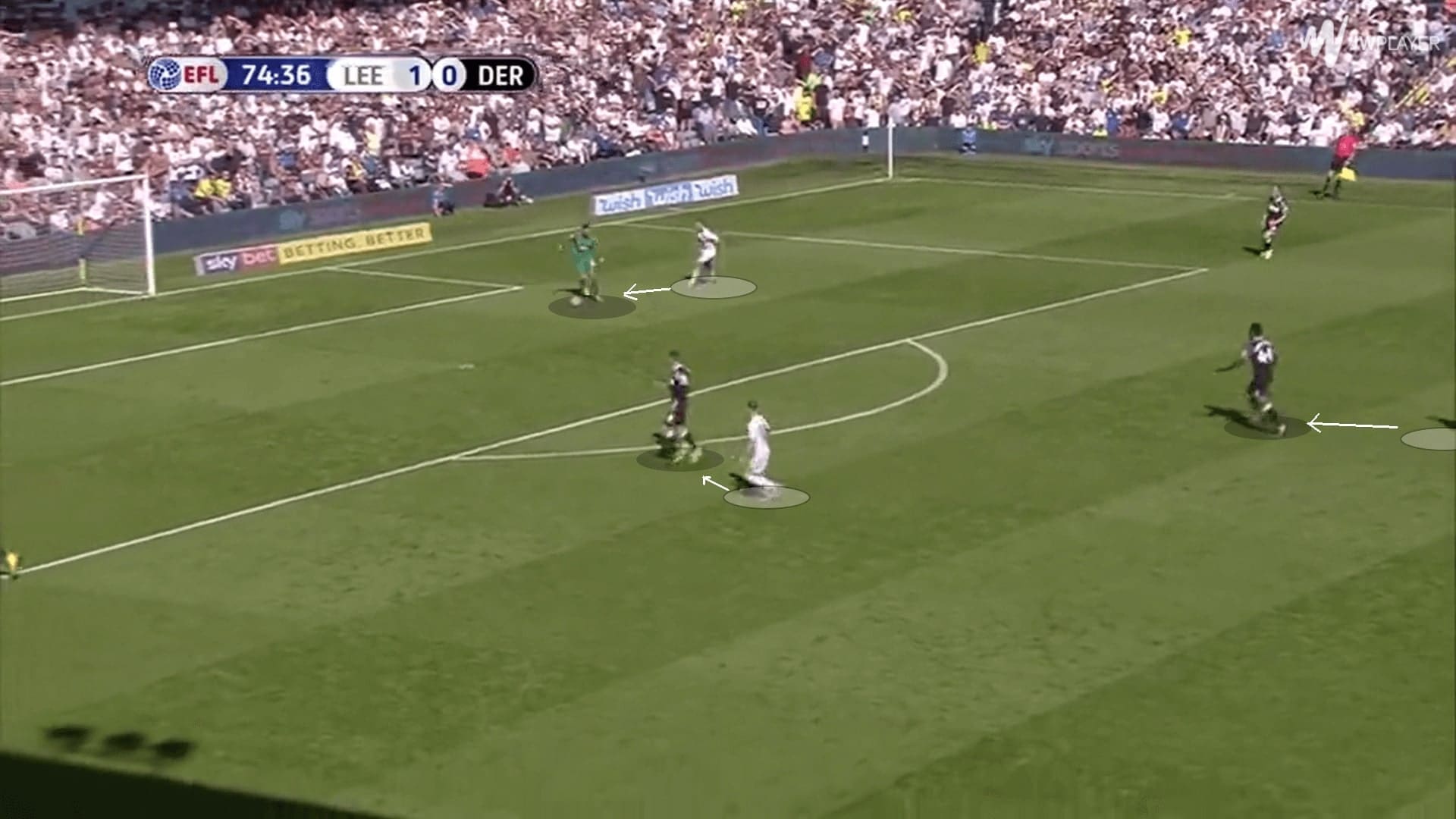
In the above example, we should also pay attention to how the Leeds player was approaching the ball. This was a diagonal run which pressured the keeper while shutting the passing lane. Furthermore, the approaching body orientations and angles of Bielsa’s men were always good. As the objective of the counter-press was not only to force the long ball, but it was also to control the direction and destination.
Ideally, the approaching player should be running in diagonally from the wide areas, as the run would limit the passing angle of the keeper. Just like this scenario, when Harrison (No.22) jumped to press the keeper diagonally, with his body angle, he restricted the keeper’s pass to the other half of the pitch. In those cases, the pass could be read by the rest of the Leeds players early, hence why they were preparing to challenge the ball earlier.
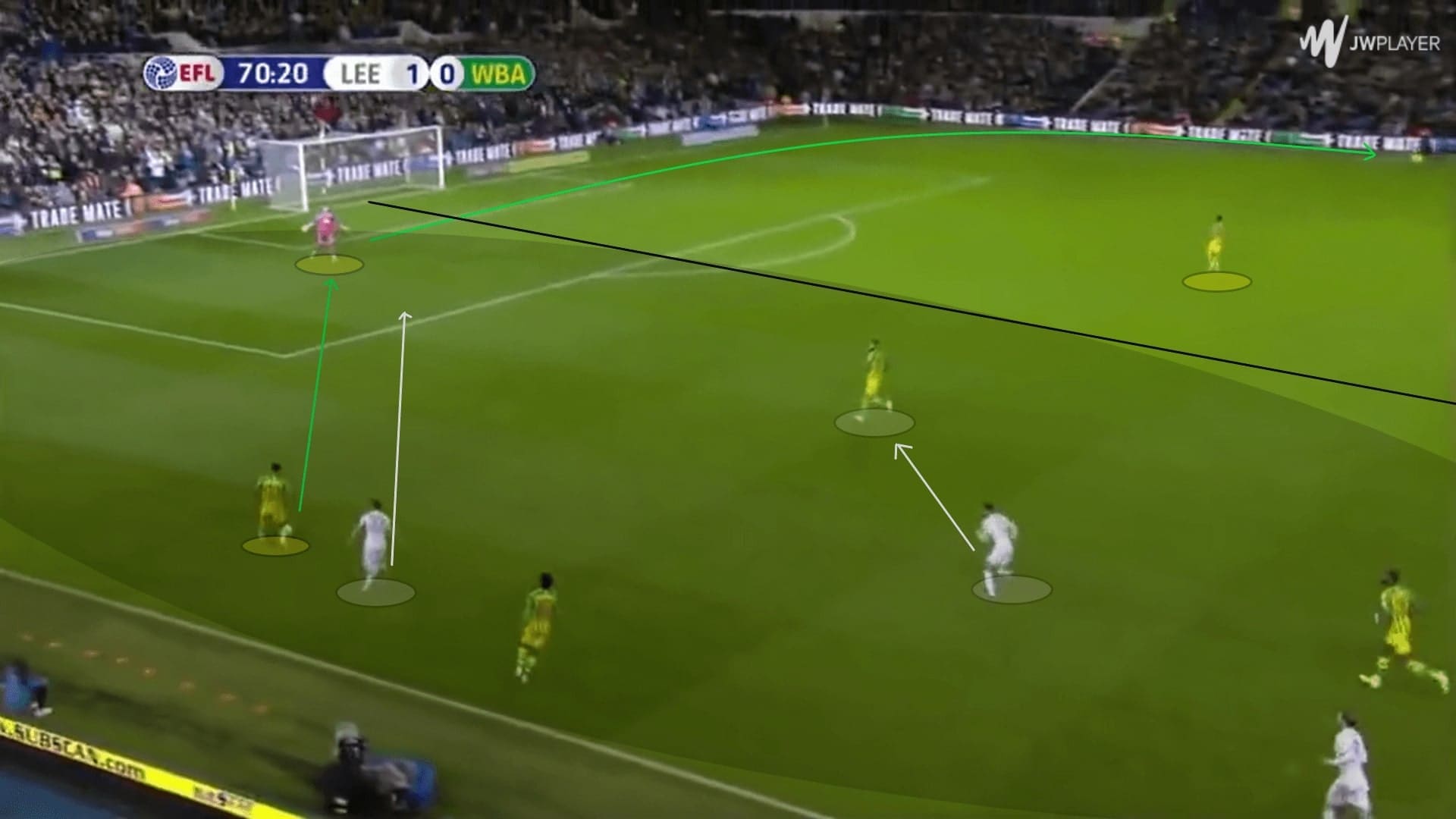
And what if the Leeds players were not close enough to force a return pass to the keeper? In those cases, the same principle still applied: one to the ball, the rest to the options. Even though they could be outnumbered on occasions, this numerical disadvantage was nullified due to the intensity and the urgency of the press.
For example, Leeds lost the ball wide in this scenario where they were outnumbered in a 5 v 6 as indicated in the below image. This was not a problem as the counter-press started instantaneously so Bristol City could hardly utilise the free player to escape. The player who pressured the ball should sprint to increase the intensity, or else the opponent would have time to perceive information and potentially play a better pass.
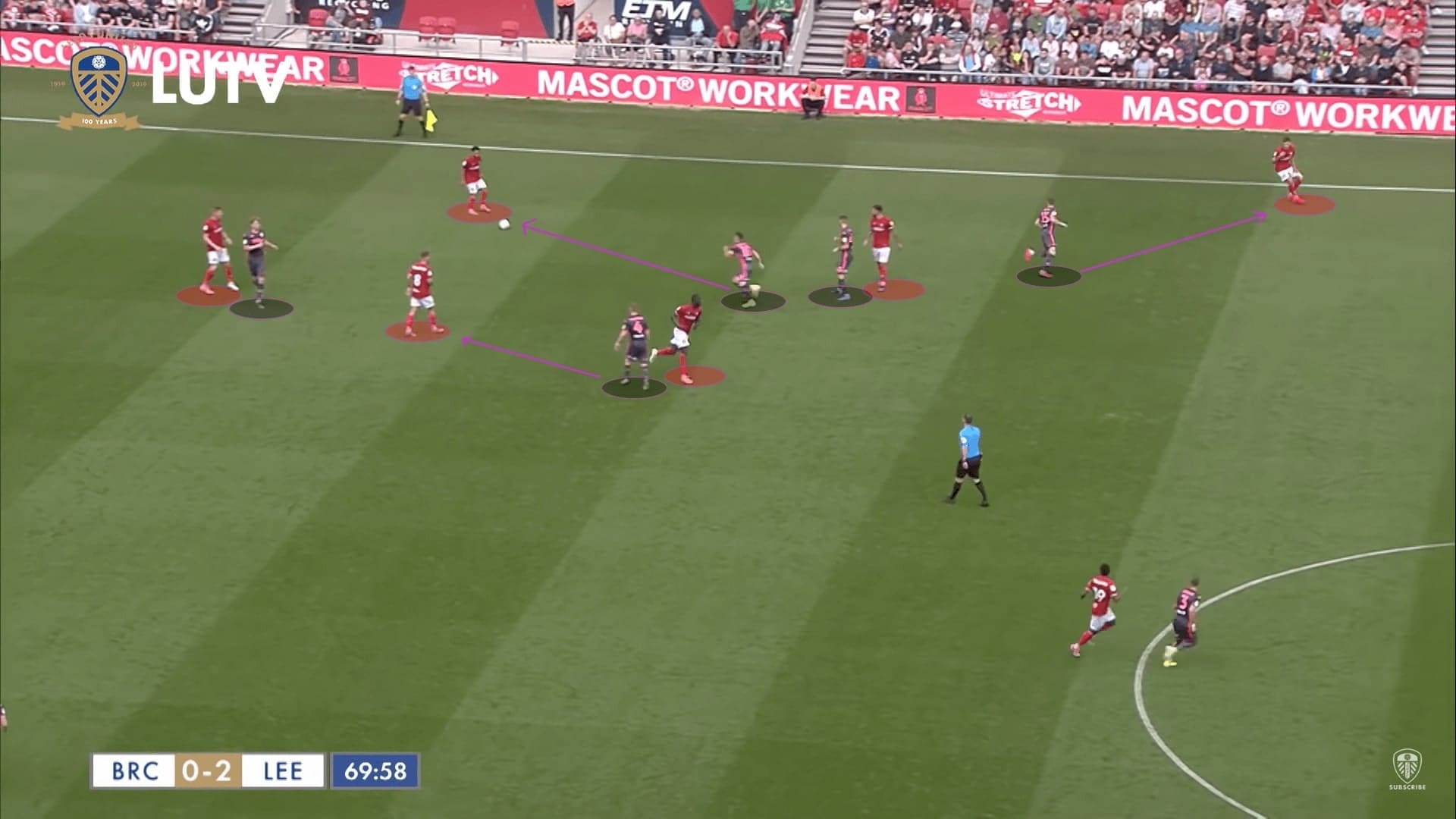
Apart from losing the second ball or misplacing a pass in the wide areas, there was also another case that we should consider – the intercepted in-balls to the centre. As Leeds were attacking the flanks, they had to find ways to access the central areas, such as playing an in-ball. This was the trickiest case as the ball was given away at the half-spaces, which means the opponents had greater room to escape from the counter-press.
The same tactic was applied in these scenarios too, though it was more difficult to execute. By theory, either the passer or the receiver should produce instant pressure on the ball when an in-ball was intercepted, depending on who was the closest man. Meanwhile, the others should man-mark the closest options around the ball. However, the central areas on the pitch might lack a Leeds player as, if you remember, we have explained Bielsa’s unique perception of spaces in our analysis earlier this week.
Below was a game example, Ezgjan Alioski’s pass was intercepted so Leeds had to counter-press even though they were outnumbered in a 2 v 3. Since Alioski gave the ball away and it was close to him, he had to jump out to press, while his teammate came near to approach the nearest target.
This scenario also reflected the importance of the counter-pressing intensity – as Alioski was approaching the ball quickly, the opponent did not have much time to think and scan his surroundings. This is the reason that he could not play the ball to the optimal option (the player behind the press). Leeds recovered the ball high because of their early reading of the pass of the Sheffield Wednesday player, but what resulted in this pass should be credited to the sprint of Alioski, who forced the pass to be early.
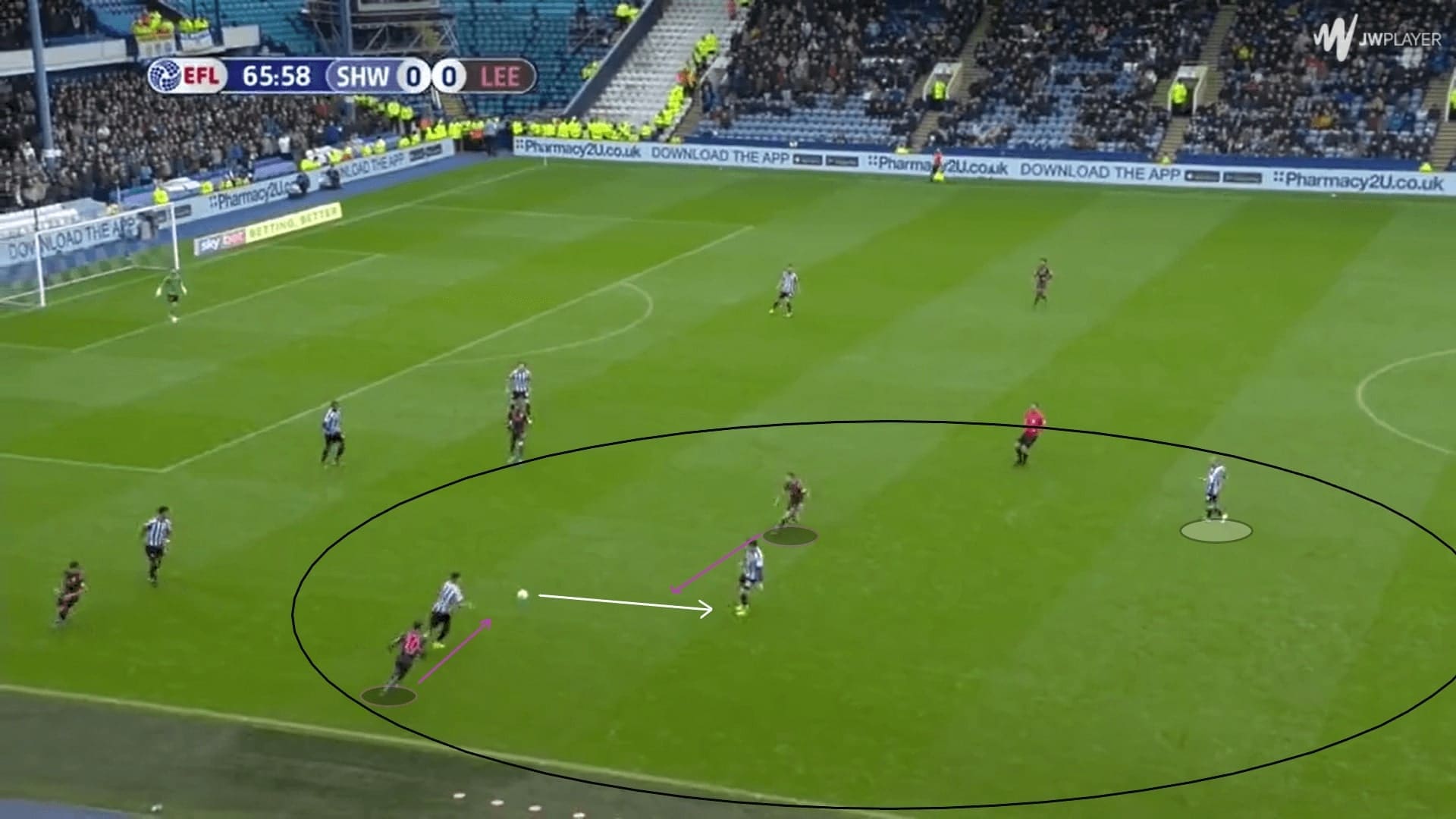
Preparation and the rest defence
Apart from explaining the scheme of the counter-press, we would also like to point out two strengths of the team which have brought them success thus far. The first was their attitude to prepare for a counter-press. In the hopes of reacting quicker than the opponents, or with better anticipating, some hardworking Leeds players would prepare the counter-press even the team was attacking. Therefore, in case the team really lost the ball, the rest of them could identify their targets in the shortest time.
One of the players with such excellent work ethic was the Manchester City loanee, Jack Harrison. Using the following image as an example, we can see Leeds were building an attack on the right. The scoreline was 3-2, and apparently, protecting the lead was important. Therefore, instead of running behind the defensive line, both Harrison and Stuart Dallas left the box and moved near to the ball. This was the preparation of a potential counter-press, and it was impressive that Harrison even checked his surroundings by looking at multiple directions. This allowed the winger to perceive as much information as he could, and then make the best decision.
These were good decisions under this context. Hypothetically, if both Dallas and Harrison tried to run behind the line and it failed, Milwall would have started and counter-attacked easily. As you could see, there was absolutely nothing behind Dallas and Harrison.
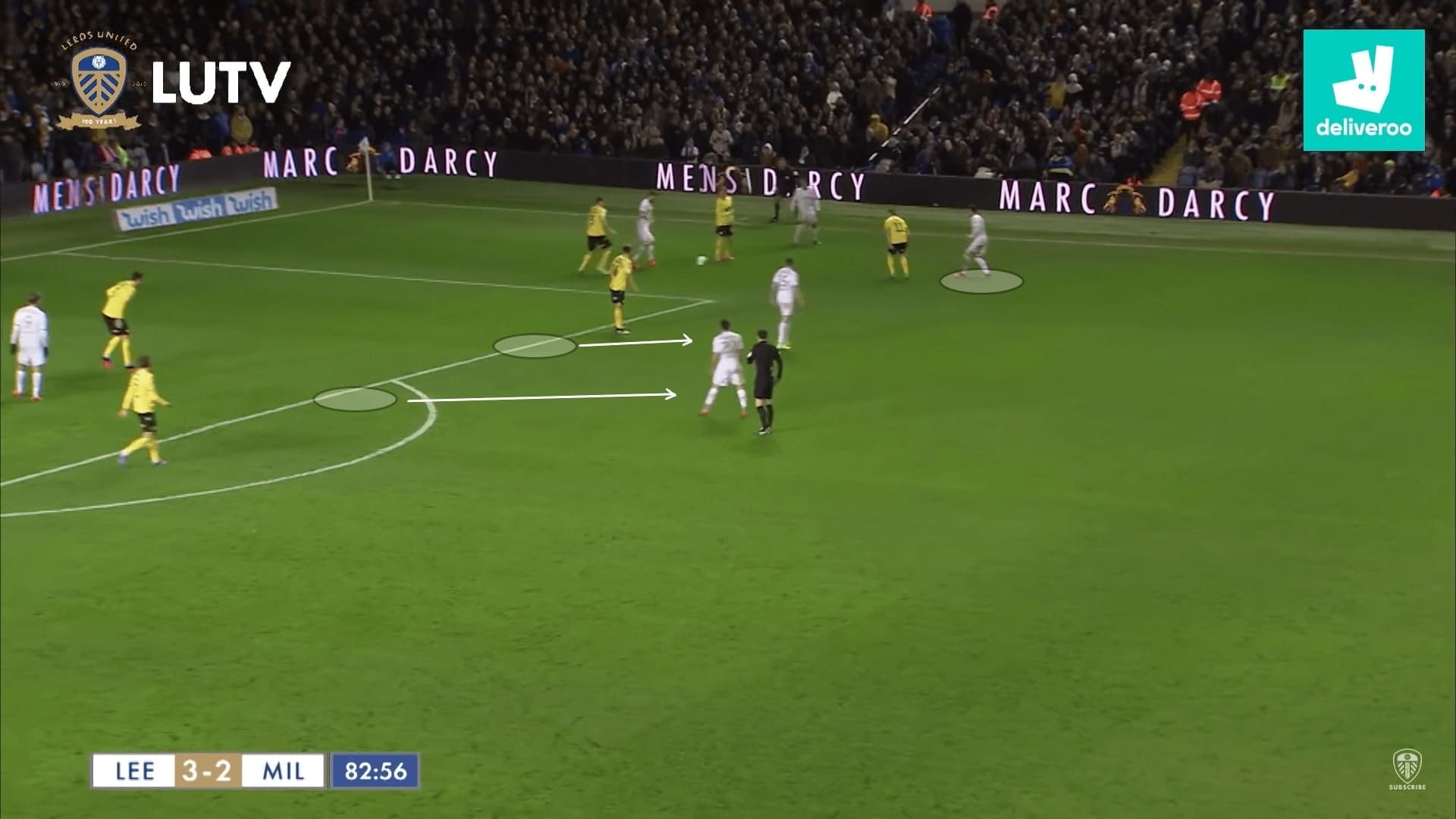
In case the counter-press was not successful, and the opponents entered Leeds’ half, how should Bielsa’s men react? If the opponent escaped by playing long, the defenders should step up and try to win the duels as they had the clearest vision on where the ball was arriving. This approach was explained in our analysis of their pressing system days ago.
So if the opponent was drifting forward and Kalvin Phillips was far from accessing him, then the task was clear. The ball-side defender (usually the CB as the FB stayed high in the attack) had to challenge the opponent while Phillips covered the spaces. Of course, it was also very fine if Phillips could access the opponent and was capable of winning the ball back.
It was demonstrated with this image. Gaetano Berardi left his position to pressure the ball while Phillips retreated to cover.
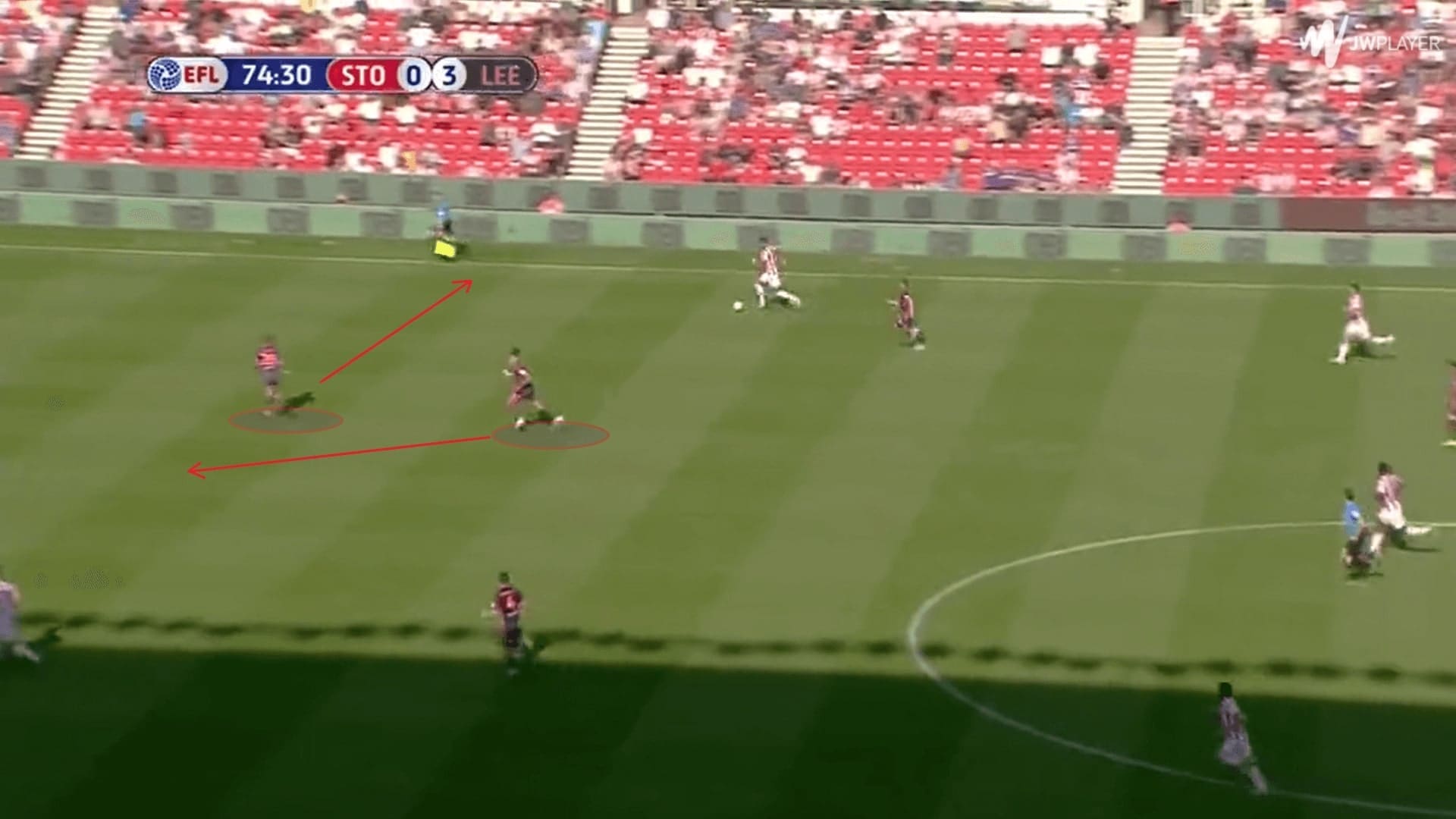
Limitations
In general, the counter-press was good, and it worked. However, it also had its limitations and we are pointing them out one by one in this section. Some of them were structural issues which were related to the team’s offensive shape. For example, the spaces behind the full-backs.
Bielsa’s full-backs, especially Alioski, liked to push very high and wide to support the attack. At the same time, large spaces on the left flank were uncovered as well. This was how their opponents exploited the flaw – they could escape from the counter-press by targeting spaces behind the full-backs. The ball was always faster than the player, and this made Leeds vulnerable in the wide areas, especially when Phillips was occupied and the defence could not shift like in the above example.
The below image is an example. We highlighted the distance between Liam Cooper and Alioski, where the gap was too large and easily identified by the opponent. Meanwhile, Phillips was occupied by Matheus Pereira and he was unable to cover the gap.
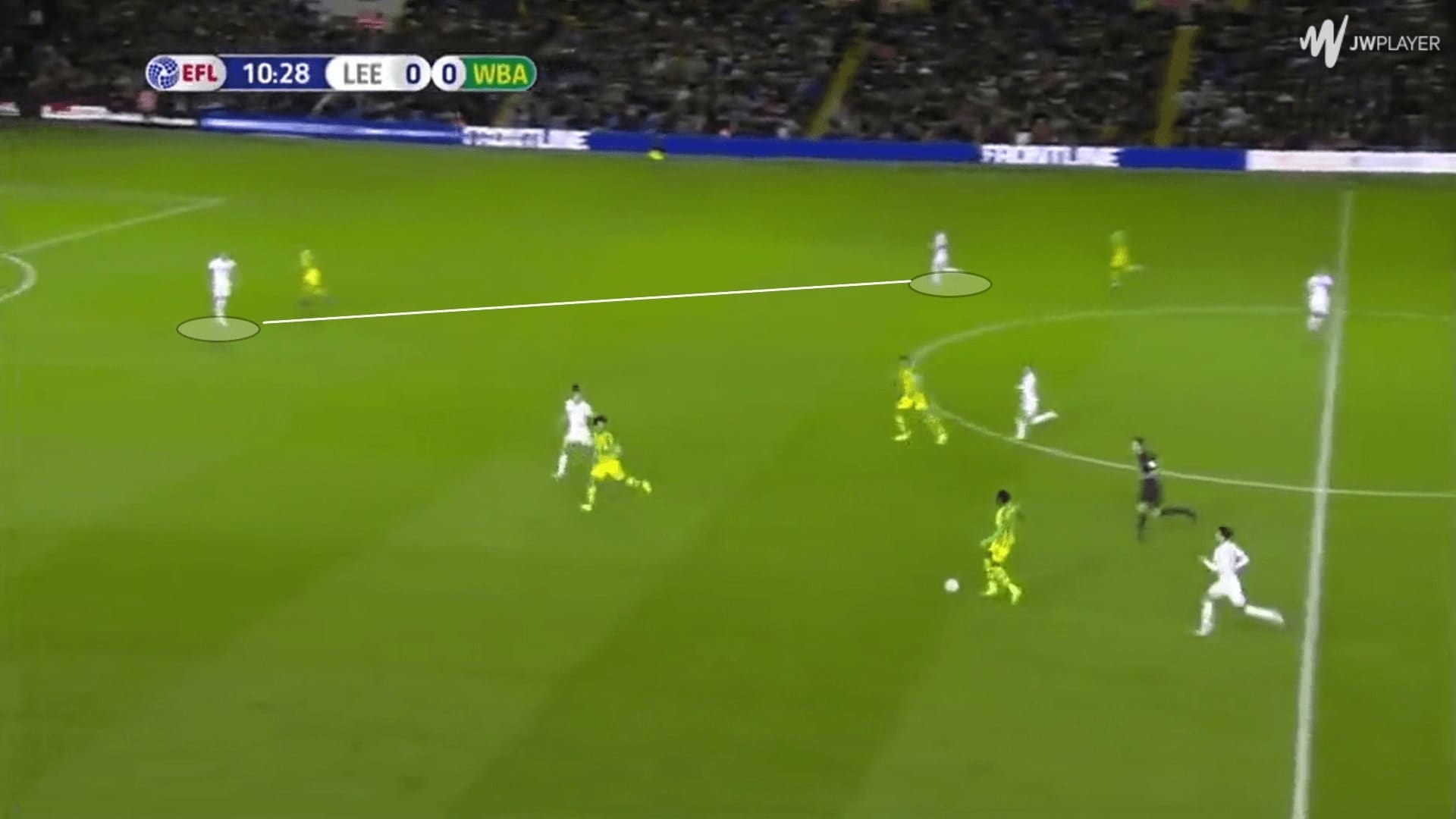
Moreover, it was not every time that Leeds could execute a counter-press. Despite strategically attacking the flanks, Leeds had to be careful, avoiding ball loss in the build-up phase. This was because of the high positioning of the midfielders, which left the vacuum of the central space. If they were sloppy to give away possession before the players were sticking together, this would be dangerous as a counter-press was not applicable.
Taking this situation as an example, Alioski tried to progress by carrying the ball forward but he lost the duel and then went onto ground. The centre was filled with West Bromwich Albion players and there were no signs of a white shirt here. In such a case, it was impossible to counter-press and West Brom created a counter-attack easily.
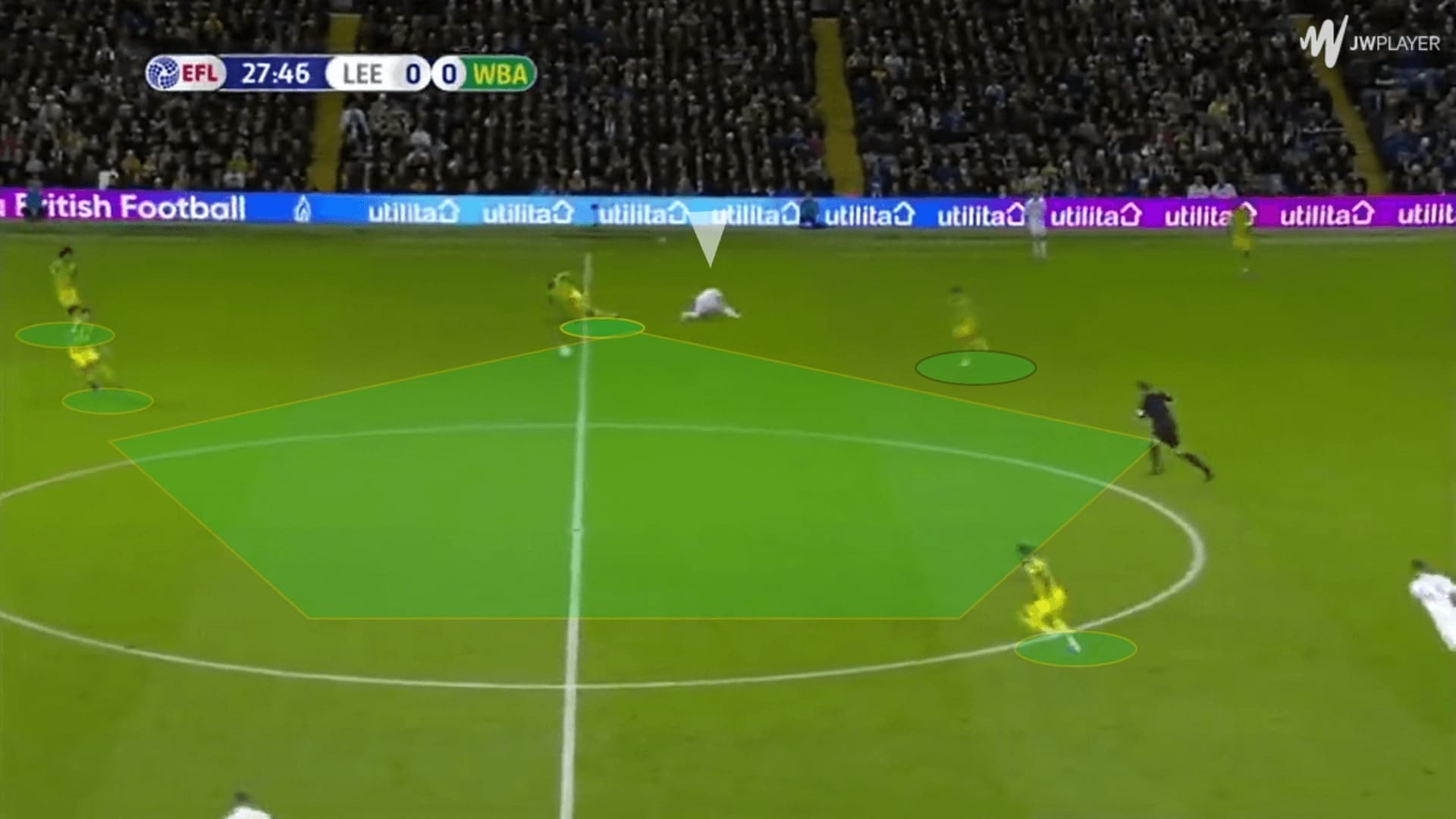
Apart from the spacing issues related to the full-backs, as shown above, the flaw of this counter-pressing system could also be exploited because of the man-marking. Since players such as Pablo Hernández were more technical and offensive players, their defensive actions were imperfect at times, and thus became the loophole of the counter-press.
When the marker was dribbled past, the counter-press collapse as the attacking team could create a potential overload (2 v 1) to develop the transition. In the below scenario, the Swansea player escaped from the challenge and enjoyed a 2 v 1 numerical advantage against Phillips. This was the reason why Phillips was unable to pressure the ball instantly.
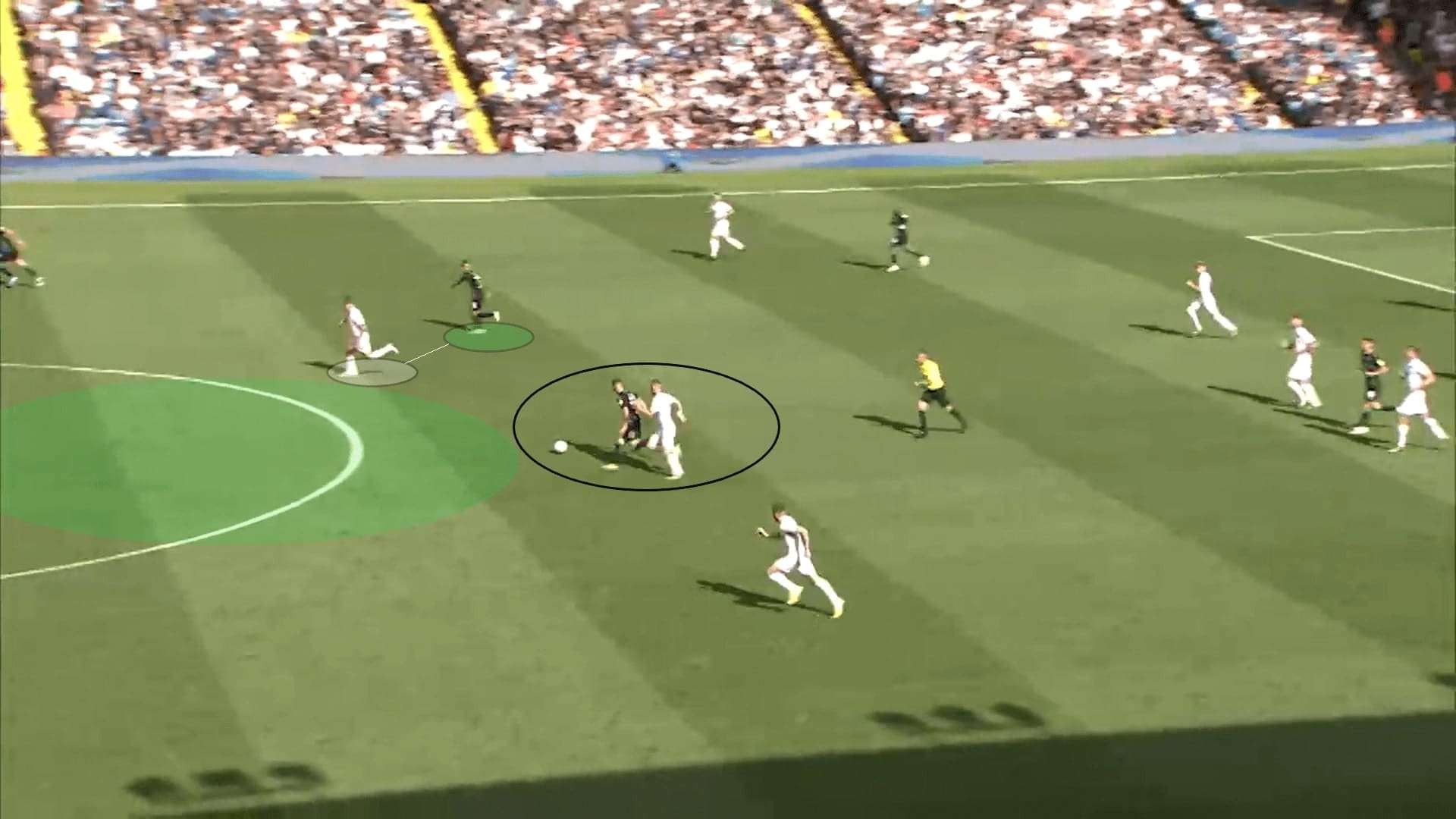
Counter-attacks
When regaining possession, Bielsa’s team always looked to exploit the defence as the opponents were likely to be disorganised. In this section, we investigate the gist of Leeds’ offensive transitions.
Stretching the defence
There were mainly two points in the counter-attacks of Leeds. First, they should try to stretch the defence in the hopes of generating spaces. Similar to their attacking setups, the early exploitation of central areas was unnecessary (occupying the centre too early would only drag all players into a tight area).
Since Leeds possessed good dribblers such as Harrison and Hélder Costa, they were strong to progress at the flanks. This also inevitably stretched the defence wide. To create such conditions, the keeper Kiko Casilla was encouraged to distribute the ball wide after gathering it.
The below image demonstrated the counter-attack. On the left, Costa was charging forward after picking the pass from the keeper. When facing two defenders, it was easy to take one out and isolate the other. Also, when the ball was out wide, the defender had to choose between looking at the ball or the player, his body orientation was suboptimal. Harrison could easily stay at Wes Harding’s (No.2) blindside during his run.
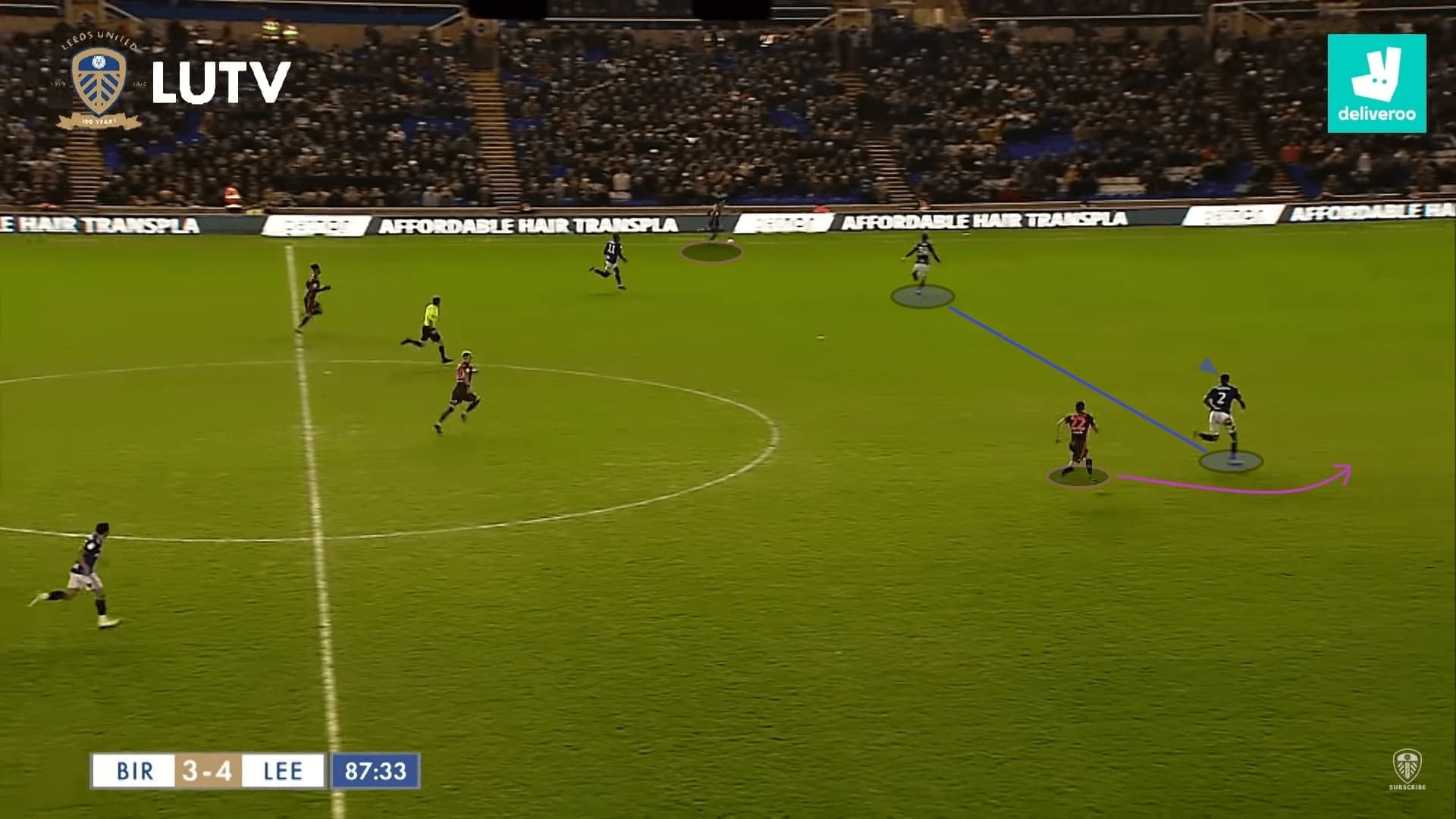
When attacking more players at the backline, there was an approach to enlarge the horizontal gaps between players. The highest player (usually, Patrick Bamford) should make an outward run to stretch the defence. So, as a result, the situation would be illustrated as the following image: Bamford’s outward movement moved the left centre-back (Kyle Bartley) wider. Meanwhile, the supporting runs should instantly utilise the horizontal gaps at the defence to look for the pass or lay off from the wide player.
The forward runs in full sprint were encouraged as it could effectively push the defence deeper, generating spaces around the ball and even preventing the defenders from stepping out.
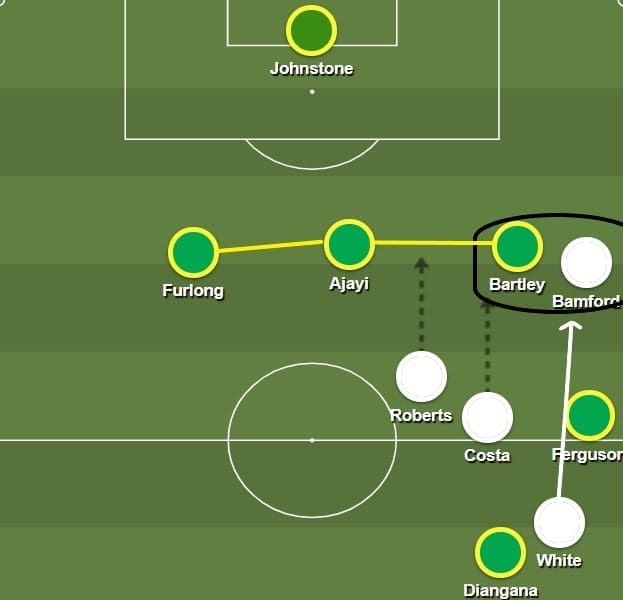
Facing the goal
Another important element of Leeds’ counter-attacks was the optimal body angle. Neither Bamford nor Jean-Kévin Augustin was the type of player that utilised the physical qualities to hold-up plays. Moreover, the target man was likely to be forced back-to-goal when resisting pressure from behind. Unless effective third man plays were possible, this was a suboptimal option otherwise.
Therefore, during the offensive transition, the Leeds player should always face to the opponents’ goal. This provided the attacking players with a clearer vision, thus, he should be able to find multiple options ahead of him. For example, this was a favourable condition created for Mateusz Klich in this image. The Polish international was carrying the ball forward and he had four options ahead of him.
This example also demonstrated the importance of stretching the defence. Despite West Brom defending with four at the back, they could hardly stay compact as four Leeds players were occupying four vertical zones evenly in the attack.
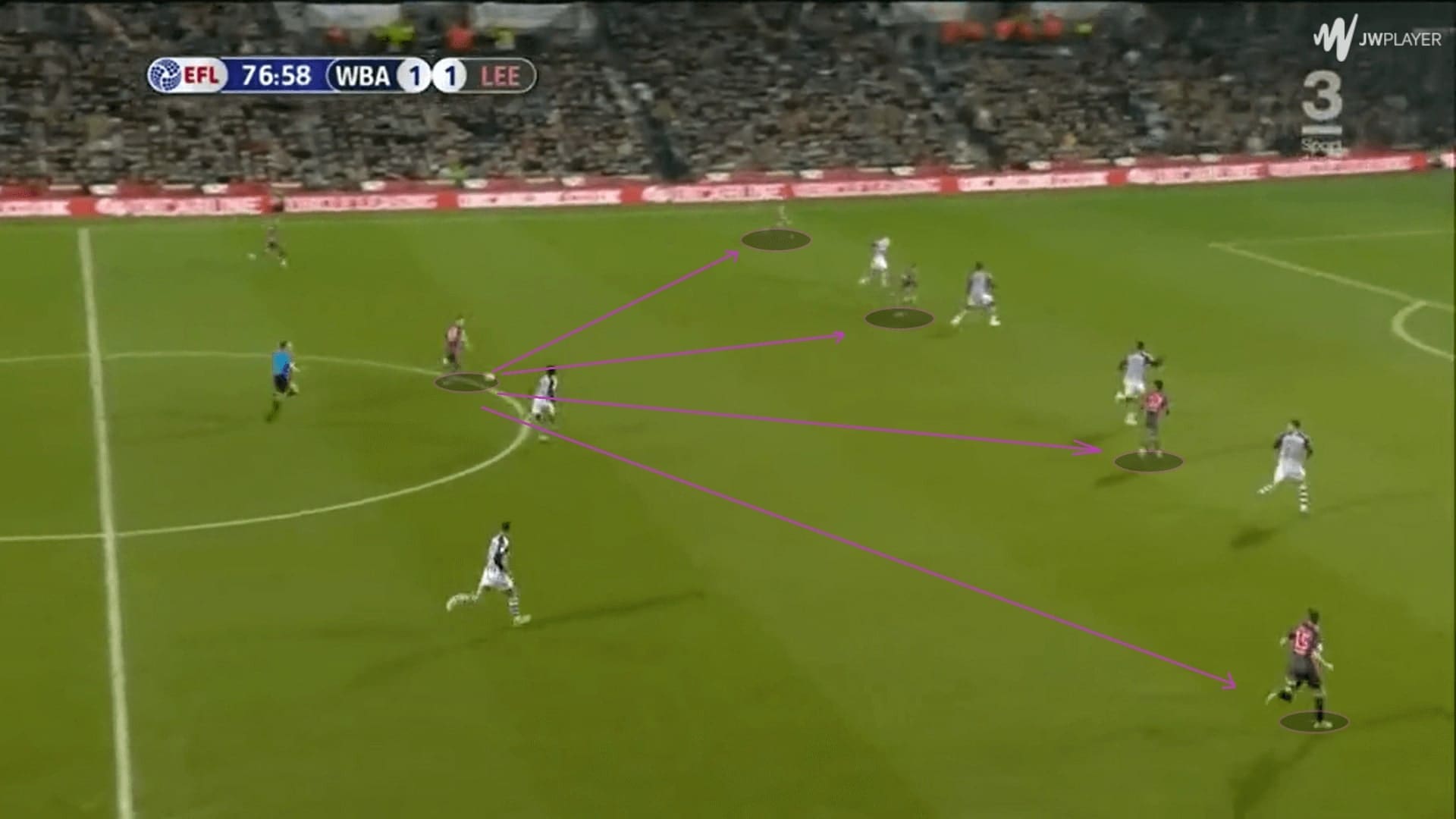
Facing to the goal was always optimal, especially when the team had good passer such as Hernández. The players were always encouraged to play a forward pass whenever identified spaces. The pass should be travelling to spaces, instead of the players’ feet, so that the receiver could continue his run in a high tempo.
In this scenario, Hernández showed his class to distribute the ball to the right flank in an offensive transition. This was a good pass as it surpassed at least three Derby County players. Also, the ball was targeting the space so the receiver could continue his sprints, reaching the goal quicker.
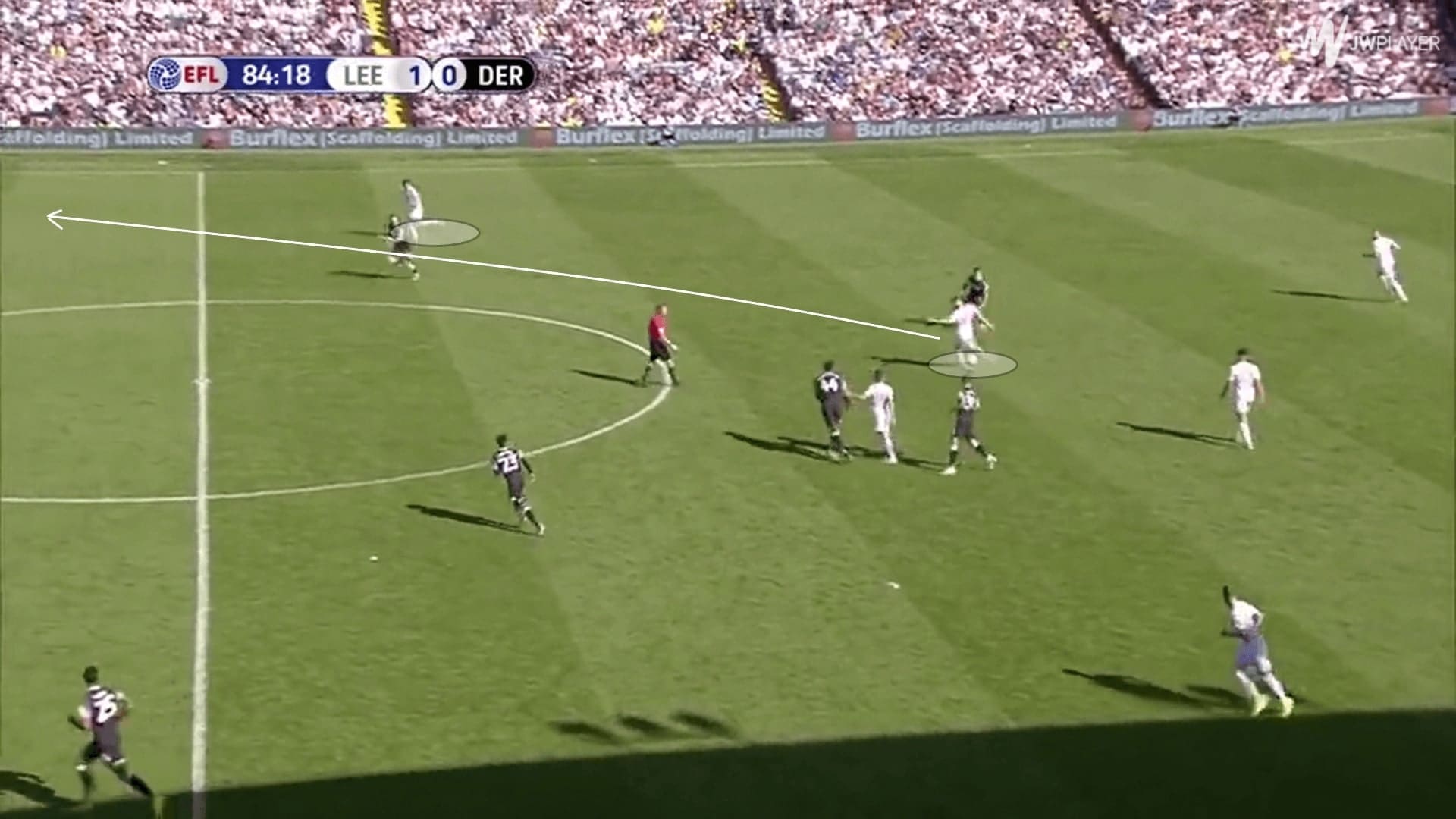
Conclusion
In this scout report, we analysed the main ideas of Leeds in their transition phases. In general, the strong counter-pressing scheme helped Bielsa’s team to dominate the game, as the high intensity allowed Leeds to win the ball back even though they were outnumbered. Despite the fact that there were some limitations, this approach has been working nicely in the EFL Championship.
The offensive transitions of Leeds were straightforward. Briefly concluding, they were a combination of space generation by stretching the defence and ensuring the optimal body orientations. The former was conducive from a macro perspective and the latter helped the individual to play easier. Under this system, several strengths of the players were fully utilised. It will be exciting to see if they are in the Premier League next season.
This is the third of our analysis on Leeds’ playing style, the final one which analyses their build-up plays would be available in the June magazine, alongside with more than 40 quality articles!





Comments